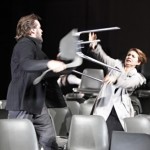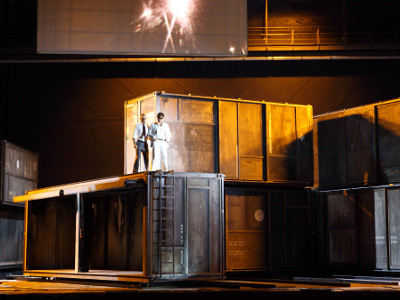by Sedgwick Clark
The Rite of Spring, the centennial of which we celebrate on May 29, has been played everywhere this season and undoubtedly will the next. But while The Rite is forever ubiquitous, much of Stravinsky’s huge output languishes—such as his rarely played sacred works, which New York’s Trinity Church presented in toto in three concerts last weekend (4/26-28). It was a genuine event, well attended, and performed sympathetically by the Choir of Trinity Wall Street, Trinity Youth Chorus, and instrumentalists from NOVUS NY under the interpretive warmth of Trinity’s music director, Julian Wachner. Appropriate for a festival of such importance, the beautifully printed and illustrated program booklet, with thought-provoking notes by Matthew Guerrieri, was a keeper.
The rarity of Stravinsky sacred-music performances is no surprise. Most of it was written during his last period, when he was adapting Schoenberg’s “method of composing with 12 tones” to his own aesthetic. While the expatriate Russian’s unique voice could not entirely be quelled, the concert-going public has voted on Schoenberg’s technique (and Stravinsky’s use of it) with its feet. After more than a century since its genesis, few 12-tone or serial works are played with any frequency, and even those are capable of emptying a room of non-believers before you can say “boo.”
The real surprise is that Stravinsky, a devoutly religious man, wrote so few works on sacred subjects. On the other hand, Ralph Vaughan Williams, an avowed atheist, composed some of the most affecting music on religious themes in the 20th century. Of all the music performed at Trinity, only the Symphony of Psalms (1930) is an indisputable masterpiece, well known and often programmed. Several critics convened at the end of the first concert, wondering which works we could “cross off the list,” as the New Yorker’s Alex Ross amusingly put it, of music we had never encountered in concert. We both had looked forward especially to Threni (1957-58) and had come armed with our scores. Wachner’s heartfelt reading was a satisfying account, even if it lacked the clarity of the composer’s recording. The same could be said of Introitus: T.S. Eliot in Memoriam (1965) and Abraham and Isaac (1962-63), the latter a minor revelation due to Sanford Sylvan’s expert vocalism. The performance of The Flood (1961-62) was game, but I find the music arid.
I could never get into the 1948 Mass before this lovely Trinity performance, but whatever delights some find in Canticum Sacrum (which Time magazine headlined “Murder in the Cathedral” for its report on the 1956 Venice premiere) escape me still, as do most of the shorter pieces. But Requiem Canticles (1966)—which Stravinsky called his “pocket requiem” and which was performed at his funeral—is his last masterpiece, albeit a small one, and it was given an eloquent account.
The Symphony of Psalms, the final work in the concerts, was performed in a two-piano arrangement by Karen Keating—a decision that on paper seemed disappointing but that largely avoided the one serious drawback of these concerts: the muddying factor of Trinity Church’s cavernous acoustics, which compromised nearly every performance to some degree. Stravinsky’s rhythms and scoring thrive in utmost clarity, and these performances would have been even more successful in the drier Zankel or Tully halls uptown.
Nevertheless, in the Symphony the superb Trinity chorus could be heard at its full stature without the acoustical confusion of orchestral textures, and the excellent pianists, Pedja Muzijevic and Steven Beck, were perfectly balanced. I’d love to hear Bruckner Motets at Trinity someday.
Colin Davis in the Green Room
My good friend and loyal reader of this blog, the conductor, educator, and author John Canarina, wrote to me of a post-concert encounter he observed between the late Colin Davis and a young musician:
“In the year 2002, I think it was, I went back to the green room after Colin Davis had conducted a NY Phil concert. The only people there ahead of me were a couple with their young son, about 10 years old. When Davis appeared the couple asked if they could take a picture of him with their son, who was studying music. He readily agreed and, in the process, asked the boy what instrument he played. “I play the clarinet,” was the reply, whereupon Davis exclaimed, ‘That’s what I played—look what happened!’”
Looking Forward
My week’s scheduled concerts (8:00 p.m. unless otherwise noted):
5/3 at 7:00. Carnegie Hall. Evgeny Kissin, piano. Beethoven: Sonata No. 32, Op. 111. Works by Haydn, Schubert, and Liszt.
5/3 at 9:00. Zankel Hall. Kronos Quartet; David Krakauer, clarinet. Missy Mazzoli: You Know Me From Here. Valentin Silvestrov: String Quartet No. 3. Aleksandra Vrebalov: Babylon, Our Own. Laurie Anderson: Flow.
5/4 at 7:30. Carnegie Hall. Renée Fleming, soprano and host; Jeremy Denk, piano; Emerson String Quartet; Paul Neubauer, viola; Colin Carr, cello. R. Strauss: Drei Lieder der Ophelia, Op. 67. Brahms: Ophelia Lieder. Schoenberg: Verklärte Nacht. Wagner: Wesendonck Lieder, Op. 91 (2). Brahms: Intermezzi, Op. 118, Nos. 1 and 2. Songs by Weigl, Wellesz, Webern, Zeisl, and Schoenberg.
5/5 at 3:00. Carnegie Hall. Maurizio Pollini, piano. Beethoven: Sonata No. 8, Op. 13 (Pathétique); Sonata No. 21, Op. 53 (Waldstein); Sonata No. 24, Op. 78; Sonata No. 23, Op. 57 (Appassionata).
5/6 at 7:30. Carnegie Hall. Spring for Music. Baltimore Symphony/Marin Alsop; Time for Three (string trio). Jennifer Higdon: Concerto 4-3. John Adams: Shaker Loops. Prokofiev: Symphony No. 4 (1947 version).
5/7 at 7:30. Carnegie Hall. Spring for Music. Albany Symphony/David Alan Miller; Kevin Cole, piano. Harbison: The Great Gatsby Suite. Gershwin: Second Rhapsody. M. Gould: Symphony No. 3 (original version).
5/8 at 7:30. Carnegie Hall. Buffalo Philharmonic/JoAnne Falletta. Kancheli: “Morning Prayers” from Life Without Christmas. Glière: Symphony No. 3 (Ilya Muromets).
5/9. Avery Fisher Hall. Audra McDonald in Concert: Go Back Home


